Three Ways to Raise Pigeons
Pigeons were traditionally raised in a Dovecote, where they were allowed to fly free, but where the squabs, eggs, and manure could be harvested by a keeper. This was fairly low maintenance way of keeping Pigeons, and is not terribly practical anymore, due to problems with letting your livestock free-range on other people's property. Not good manners, especially when it involves Pigeon droppings!
The two most common ways of raising Pigeons now, are in cages, or in a larger Colony dovecote. Either one may also be referred to as a Pigeon Loft, or one of several other names. Breeders of sport and show birds are more likely to call it a Loft.
Cages allow you to carefully control breeding, and to carefully control feed. Usually for meat Pigeons, this is less critical than with sport or show birds. Cages are still a good option for small spaces, and for selective breeding for overall improvement of the breed lines.
The disadvantage to cages is that the birds do not have room to fly. While they can be raised well without flying, they are generally happier and healthier if they can.
Cages are often used for Commercial meat birds for the reason that it is simply easier to automate and track some things in a cage environment without having to read leg bands.
A colony dovecote or loft is possibly the most popular way of raising Pigeons for meat production on a farm. Dovecotes range from small ones holding just a few pairs, up to those that hold hundreds of pairs. It is often stated that more than about 30 pairs is not as manageable, so most small farm facilities have 30 or fewer pairs.
A colony dovecote or loft is often attached to a flight pen, to give the birds more free flying space, as an alternative to the old method of letting them fly freely from the dovecote.
In a colony setting, birds are usually able to select their own mates, though this can be controlled if you have a means of separating a pair off until they begin to nest together.
Colony rearing is simply less costly, and daily management is a little less tedious. Productivity can be tracked on banded birds.
The third way that works as a nice compromise between cages and Colony rearing is to combine the two. You can do this any number of ways, but it usually involves either using a Colony with a few individual cages for selective breeding and isolating birds when needed for other purposes, or using cages that are connected to a common flight pen, so that nesting and night accommodations are separated, but daytime flight areas are shared.
Either of these options allows you to use the advantages of cages, with the advantages of colony rearing, while minimizing the negatives for each option.
Very often, the way we end up doing things is less a matter of what we feel is ideal, than it is the closest we could get to that ideal given our circumstances. Available land, materials, and funds will often affect the end results more than what we really wanted or thought was best. Reality often requires compromise.
However you choose to design your Pigeon space, be as generous as you can with your birds, and you'll gain more in productivity, health, and enjoyment.
Click to Download Your Free Heritage Pickling and Culturing e-Book Now!
Instant Download, NO Registration Required!






